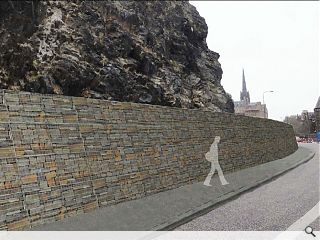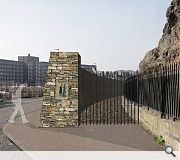Edinburgh Castle rock fall wall plan submitted
September 13 2013
Plans to erect a 3m high stone filled gabion wall along Johnston Terrace, Edinburgh Castle have been submitted by Historic Scotland in a bid to contain the risk presented by falling rocks.The £1m project has been necessitated by ongoing erosion which has caused rock fragments to detach from the 360m year old volcano, damaging cars parked on the street below.
To contain this risk both netting and regular inspection work is carried out but this has only served to mitigate the risk and carries its own expense in terms of labour and management..
Now, to solve the problem completely, Historic Scotland is proposing a physical barrier of Pitairlie sandstone gabions to guard against future damage.
In their design statement Historic Scotland said: “Previous interventions have been constrained by the limits of the site and the proximity of the road, but recent discussions with CEC established that they were not averse to off-setting a reduced road width on part of Johnston Terrace, against a significant reduction in risk of potential rockfall damage, and any consequent transport disruption.
“This gave greater scope for consideration of a combination of a physical barrier, and a rock containment zone in this area, occupying the north footpath, and a strip of the carriageway. Computer modelling was used to assist in determining the optimum position for such a rock containment barrier at road level at the base of the rock slope, and the temporary steel barrier, which has been in place since April 2013, is based on these calculations."
6 Comments
#1 Posted by Egbert on 13 Sep 2013 at 15:07 PM
Looks fine. Johnson Terrace is over-wide anyway - typical Victorian urban intervention, blasting its way into the head of the Old Town with minimum sensitivity. For the most part it'll only be tourist coaches affected - I'm sure locals will shed few tears...
#2 Posted by Parallel world on 16 Sep 2013 at 08:20 AM
So, given this will effect the setting of a listed building, will the council refer this to HS for review? Go on HS, turn it down, a gabion wall is clearly too utilitarian and lacking in any subtlety or historical reference.
Not to mention the curious relationship of the two walls with a no mans land between them and pedestrian zone squeezed to nothing.... How's this relate to 'Designing Streets' or 'Creating Places'?
Not to mention the curious relationship of the two walls with a no mans land between them and pedestrian zone squeezed to nothing.... How's this relate to 'Designing Streets' or 'Creating Places'?
#3 Posted by realistically on 16 Sep 2013 at 13:11 PM
parallel world say 'no mans land' well yes thats the idea to minimise the risk of persons being struck by falling rocks......
#4 Posted by Greyfriar's Bobby on 16 Sep 2013 at 13:28 PM
That footpath doesn't look nearly wide enough for the fleets of buses disgorging tourists onto Johnston Terrace.
#5 Posted by Parallel Doh on 16 Sep 2013 at 20:12 PM
#3 - well of course, but there's surely other ways of dealing with this than to have to parallel non descript walls with a bit of unusable pavement between them. Some occupiable/landscape/structural element that adds to the place rather than just taking up space...
Really lacking in imagination - good topic for a design maquette for returning students I think...
Really lacking in imagination - good topic for a design maquette for returning students I think...
#6 Posted by realistically on 20 Sep 2013 at 13:03 PM
#5 - it would have to be a bunker to prevent rocks going through with some sort of absorbant roof to stop them bouncing off into the road or a high parapet - did you read the bit about falling rocks?
Post your comments
Back to September 2013
Like us on Facebook
Become a fan and share
News Archive
Search News
Features & Reports
For more information from the industry visit our Features & Reports section.




